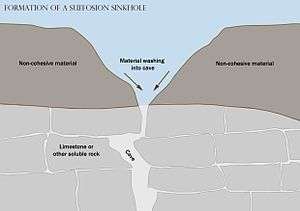Suffosion
Suffosion is one of the two geological processes by which subsidence sinkholes or dolines are formed, the other being due to collapse of an underlying cave or void,[1] with most sinkholes formed by the suffosion process.[2] Suffosion sinkholes are normally associated with karst topography although they may form in other types of rock including chalk, gypsum and basalt. In the karst of the UK's Yorkshire Dales, numerous surface depressions known locally as "shakeholes" are the result of glacial till washing into fissures in the underlying limestone.[3]

Process
Suffosion occurs when loose soil, loess, or other non-cohesive material lies on top of a limestone substratum containing fissures and joints. Rain and surface water gradually wash this material through these fissures and into caves beneath.[2] Over time, this creates a depression on the landscape of varying depth.
Examples
The following sites are examples of sinkholes formed by suffosion:
- Whitepit, south of Priddy, Somerset, UK;
References
- Waltham, T.; Bell, T.; Culshaw, M. (2005). Sinkholes and Subsidence. Berlin: Springer. ISBN 978-3540207252.
- "Dolines and sinkholes". British Geological Survey. Retrieved February 21, 2011.
- Waltham, T. "Ground Subsidence". Retrieved February 21, 2011.